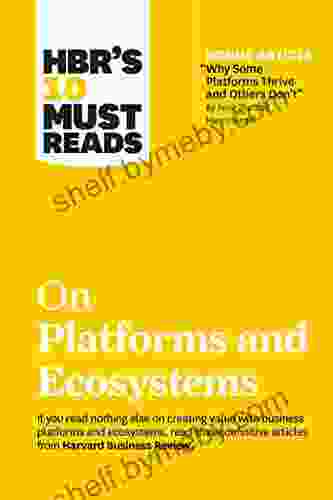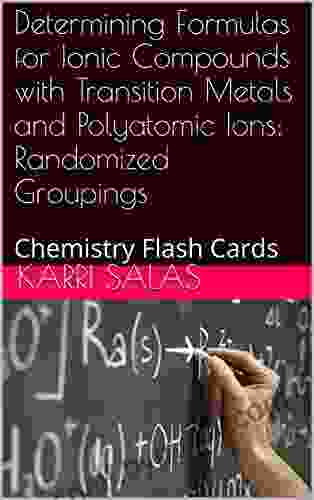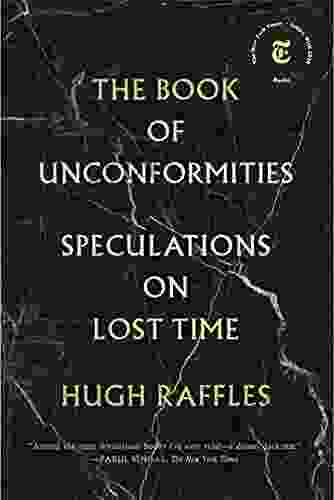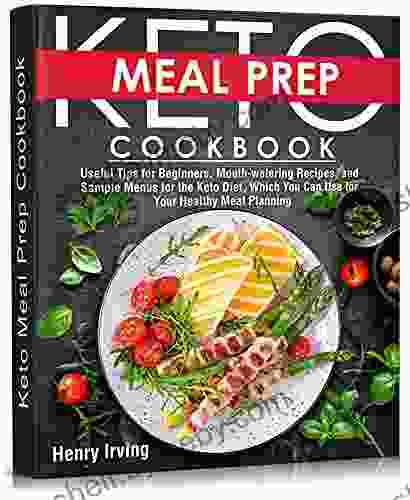Determining Formulas For Ionic Compounds With Transition Metals And Polyatomic

Unveiling the Secrets of Chemical Bonding
The world of chemistry is vast and ever-evolving, with each new discovery revealing a deeper understanding of the intricate world of atoms and molecules. Among the fundamental concepts that govern the behavior of chemical substances is the formation of ionic compounds, a class of compounds that play a crucial role in numerous biological, industrial, and everyday processes.
Ionic compounds, as the name suggests, are formed when a metal loses one or more electrons, becoming a positively charged ion (cation),and a non-metal gains the lost electrons, becoming a negatively charged ion (anion). The electrostatic attraction between these oppositely charged ions holds the compound together in a stable crystal lattice.
5 out of 5
| Language | : | English |
| File size | : | 4774 KB |
| Screen Reader | : | Supported |
| Print length | : | 132 pages |
| Lending | : | Enabled |
The Enigmatic Transition Metals
Transition metals, with their versatile electronic configurations and ability to exhibit multiple oxidation states, add an extra layer of complexity to the world of ionic compounds. These metals, found in the middle of the periodic table, possess the unique ability to form ions with varying charges, giving rise to a wider range of possible compounds.
Understanding the behavior of transition metals is essential for accurately determining the formulas of ionic compounds. Their variable oxidation states require careful consideration when balancing the charges of the ions involved, ensuring the compound's overall electrical neutrality.
Polyatomic Ions: A Symphony of Molecular Complexity
Adding another layer of complexity to the realm of ionic compounds are polyatomic ions, groups of atoms that carry a net charge and behave as a single unit. These ions, often composed of multiple non-metal atoms, introduce a diverse array of bonding possibilities and further expand the landscape of ionic compounds.
掌握多原子离子的特性和命名法对于确定离子化合物的正确公式至关重要。它们独特的结构和电荷分布需要仔细考虑,以确保化合物的化学计量平衡。
A Step-by-Step Guide to Formula Determination
Determining the formulas for ionic compounds involving transition metals and polyatomic ions requires a systematic approach, taking into account the principles of chemical bonding and the properties of the individual ions involved.
1. Identify the Ions: Begin by identifying the metal and non-metal elements present in the compound. For transition metals, determine their oxidation state based on the given information or context. For polyatomic ions, refer to a list of common polyatomic ions and their charges.
2. Balance the Charges: The total positive charge of the cations must equal the total negative charge of the anions to achieve electrical neutrality. Adjust the subscripts of the ions accordingly, ensuring the overall charge of the compound is zero.
3. Write the Formula: Once the charges are balanced, write the chemical formula of the ionic compound using the symbols and subscripts of the balanced ions. The formula should represent the simplest whole-number ratio of the ions.
Examples to Illuminate the Path
Consider the following examples to solidify your understanding of formula determination:
Example 1: Iron(III) Oxide
Iron(III) has a charge of +3, and oxide has a charge of -2. To balance the charges, we need two iron(III) ions for every three oxide ions. The formula for iron(III) oxide is therefore Fe2O3.
Example 2: Potassium Permanganate
Potassium is a metal with a charge of +1, and permanganate is a polyatomic ion with a charge of -1. To balance the charges, we need one potassium ion for every permanganate ion. The formula for potassium permanganate is therefore KMnO4.
: Unlocking the Secrets of Ionic Compounds
Determining formulas for ionic compounds involving transition metals and polyatomic ions is an essential skill for mastering inorganic chemistry. By understanding the principles of chemical bonding, the properties of these unique ions, and the step-by-step approach to formula determination, you can unveil the secrets of these fascinating compounds and expand your knowledge of the intricate world of chemistry.
Remember, the journey of scientific discovery is an ongoing pursuit, and the world of chemistry is constantly evolving. Embrace the challenges and continue to explore the depths of this captivating field, unraveling the mysteries of chemical bonding one formula at a time.
5 out of 5
| Language | : | English |
| File size | : | 4774 KB |
| Screen Reader | : | Supported |
| Print length | : | 132 pages |
| Lending | : | Enabled |
Do you want to contribute by writing guest posts on this blog?
Please contact us and send us a resume of previous articles that you have written.
 Book
Book Novel
Novel Page
Page Chapter
Chapter Text
Text Story
Story Genre
Genre Reader
Reader Library
Library Paperback
Paperback E-book
E-book Magazine
Magazine Newspaper
Newspaper Paragraph
Paragraph Sentence
Sentence Bookmark
Bookmark Shelf
Shelf Glossary
Glossary Bibliography
Bibliography Foreword
Foreword Preface
Preface Synopsis
Synopsis Annotation
Annotation Footnote
Footnote Manuscript
Manuscript Scroll
Scroll Codex
Codex Tome
Tome Bestseller
Bestseller Classics
Classics Library card
Library card Narrative
Narrative Biography
Biography Autobiography
Autobiography Memoir
Memoir Reference
Reference Encyclopedia
Encyclopedia Helle Katrine Kleven
Helle Katrine Kleven Ina May Gaskin
Ina May Gaskin Marilyn M Litvak
Marilyn M Litvak Judith Rich Harris
Judith Rich Harris Jesse Mecham
Jesse Mecham Henry Kissinger
Henry Kissinger Rolf G Poluha
Rolf G Poluha Stefan Hunziker
Stefan Hunziker Howard Carter
Howard Carter Rachel Trethewey
Rachel Trethewey Heather Lehr Wagner
Heather Lehr Wagner Roberto Fermino
Roberto Fermino Henry Stedman
Henry Stedman Matt Lemay
Matt Lemay Mary Ellen Iskenderian
Mary Ellen Iskenderian Timothy P Schultz
Timothy P Schultz Herb Leonhard
Herb Leonhard Ian Young
Ian Young Michael Dever
Michael Dever Howard Raiffa
Howard Raiffa
Light bulbAdvertise smarter! Our strategic ad space ensures maximum exposure. Reserve your spot today!

 Morris CarterIntrepid Dudettes of the Inca Empire: Unveiling the Hidden History of Fierce...
Morris CarterIntrepid Dudettes of the Inca Empire: Unveiling the Hidden History of Fierce...
 Dustin RichardsonHBR 10 Must Reads on Platforms and Ecosystems: The Ultimate Guide to Business...
Dustin RichardsonHBR 10 Must Reads on Platforms and Ecosystems: The Ultimate Guide to Business... Desmond FosterFollow ·7.3k
Desmond FosterFollow ·7.3k Banana YoshimotoFollow ·8k
Banana YoshimotoFollow ·8k Greg FosterFollow ·16.7k
Greg FosterFollow ·16.7k Victor TurnerFollow ·2.5k
Victor TurnerFollow ·2.5k Philip BellFollow ·8k
Philip BellFollow ·8k Allen ParkerFollow ·2.4k
Allen ParkerFollow ·2.4k Vic ParkerFollow ·9.6k
Vic ParkerFollow ·9.6k Ralph Waldo EmersonFollow ·3.2k
Ralph Waldo EmersonFollow ·3.2k

 Bo Cox
Bo CoxUncover the Enchanting Pearl of the Arabian Gulf: Insight...
Escape to the opulent...

 Michael Crichton
Michael CrichtonInsight Guides Pocket Baku Travel Guide Ebook: Your...
An Enchanting Journey...

 Eugene Scott
Eugene ScottLearn to Paint Scenic Scenes: Unveil the Secrets of...
Step into the...

 Benji Powell
Benji PowellEmbark on a Culinary Adventure with "The Ultimate Sichuan...
Sichuan cuisine,...

 Finn Cox
Finn CoxDiscover the Enchanting World of Art Nouveau: A...
Immerse yourself in the captivating beauty...

 Corey Green
Corey GreenUncover the Vibrant World of Guatemalan Chicken Buses: An...
Step into a world of vibrant colors,...
5 out of 5
| Language | : | English |
| File size | : | 4774 KB |
| Screen Reader | : | Supported |
| Print length | : | 132 pages |
| Lending | : | Enabled |








